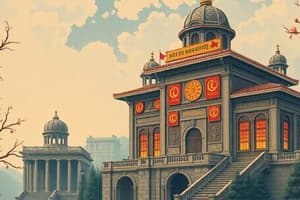Podcast
Questions and Answers
Which action taken by the Mexica rulers was LEAST likely to have contributed to the long-term stability of their empire?
Which action taken by the Mexica rulers was LEAST likely to have contributed to the long-term stability of their empire?
- Commissioning monumental architecture to inspire awe and demonstrate the empire's wealth and power.
- Implementing a complex tribute system that extracted resources from conquered territories.
- Constructing elaborate public works, such as temples and causeways, that provided employment and improved infrastructure.
- Utilizing human sacrifice on a massive scale to legitimize their rule, potentially alienating subjugated populations. (correct)
How did the Ottoman Empire's 'devshirme' system primarily function to consolidate the Sultan's authority, and why was this controversial?
How did the Ottoman Empire's 'devshirme' system primarily function to consolidate the Sultan's authority, and why was this controversial?
- By fostering economic alliances with European powers, thus securing access to advanced military technology and bolstering the Sultan's prestige.
- By granting religious minorities extensive autonomy, thus reducing interfaith conflict and promoting social cohesion.
- By creating a class of highly trained bureaucrats and soldiers directly loyal to the Sultan, thus circumventing traditional power structures; however, it involved forcibly conscripting Christian boys, causing resentment. (correct)
- By decentralizing administrative control and empowering local rulers, thus fostering regional stability and minimizing the risk of rebellions.
Which of the following scenarios BEST exemplifies the challenges faced by rulers in maintaining power due to competition over trade routes during the 1450-1750 period?
Which of the following scenarios BEST exemplifies the challenges faced by rulers in maintaining power due to competition over trade routes during the 1450-1750 period?
- The increasing conflicts between the Dutch East India Company and the British East India Company in the Indian Ocean, leading to naval battles and trade wars. (correct)
- The Ottoman Empire's implementation of the millet system, granting religious autonomy to various communities within its borders.
- The French monarchy's construction of the Palace of Versailles as a means of centralizing power and showcasing royal authority.
- The Qing Dynasty's successful suppression of the White Lotus Rebellion through military force and ideological indoctrination.
How did the adoption of Islam by the Songhai Empire most directly serve to legitimize imperial rule, and what potential challenges did it present?
How did the adoption of Islam by the Songhai Empire most directly serve to legitimize imperial rule, and what potential challenges did it present?
In what way did the Qing Dynasty's use of imperial portraits function as a tool for legitimizing power, and what underlying message were these portraits intended to convey?
In what way did the Qing Dynasty's use of imperial portraits function as a tool for legitimizing power, and what underlying message were these portraits intended to convey?
How did Sultan Suleiman I ('the Magnificent') use legal reforms to maintain power within the Ottoman Empire, and what were the limitations of these reforms?
How did Sultan Suleiman I ('the Magnificent') use legal reforms to maintain power within the Ottoman Empire, and what were the limitations of these reforms?
How did European rulers' embrace of the concept of the divine right of kings affect their ability to govern, and what were the potential consequences of this belief?
How did European rulers' embrace of the concept of the divine right of kings affect their ability to govern, and what were the potential consequences of this belief?
In what way did the salary system for Japanese samurai impact the balance of power between the Shogun and the Daimyo, and what were the long-term implications of this shift?
In what way did the salary system for Japanese samurai impact the balance of power between the Shogun and the Daimyo, and what were the long-term implications of this shift?
How did the construction and grandeur of the Palace of Versailles contribute to Louis XIV's ability to legitimize and maintain power in France, and what message was he intending to convey?
How did the construction and grandeur of the Palace of Versailles contribute to Louis XIV's ability to legitimize and maintain power in France, and what message was he intending to convey?
Which of the following scenarios BEST exemplifies how rulers in the period 1450-1750 used tribute collection to project power, and what were the potential consequences for the subjugated populations?
Which of the following scenarios BEST exemplifies how rulers in the period 1450-1750 used tribute collection to project power, and what were the potential consequences for the subjugated populations?
Flashcards
Military Strength
Military Strength
Expanding and consolidating power through military force.
Trade and Resources
Trade and Resources
Control of key trade routes and access to valuable resources to build economic strength.
Diplomacy & Marriage
Diplomacy & Marriage
Forming alliances through diplomatic negotiations and royal marriages to consolidate power.
Divine Right
Divine Right
Signup and view all the flashcards
Monumental Architecture
Monumental Architecture
Signup and view all the flashcards
Imperial Portraits
Imperial Portraits
Signup and view all the flashcards
Bureaucratic Elites
Bureaucratic Elites
Signup and view all the flashcards
Devshirme System
Devshirme System
Signup and view all the flashcards
Tribute & Tax Farming
Tribute & Tax Farming
Signup and view all the flashcards
Local Resistance
Local Resistance
Signup and view all the flashcards
Study Notes
The provided text contains duplicate information that already exists in the existing study notes. No changes or updates are necessary.
Studying That Suits You
Use AI to generate personalized quizzes and flashcards to suit your learning preferences.




